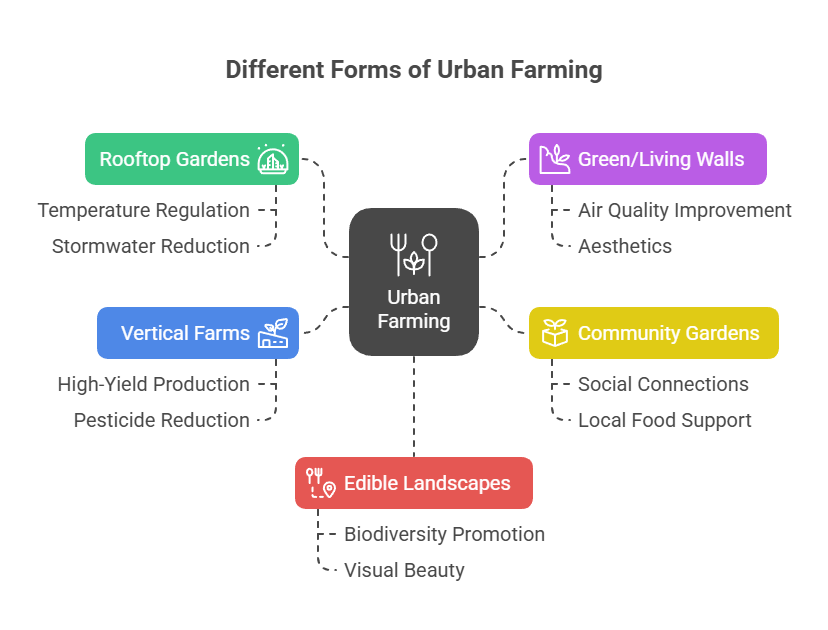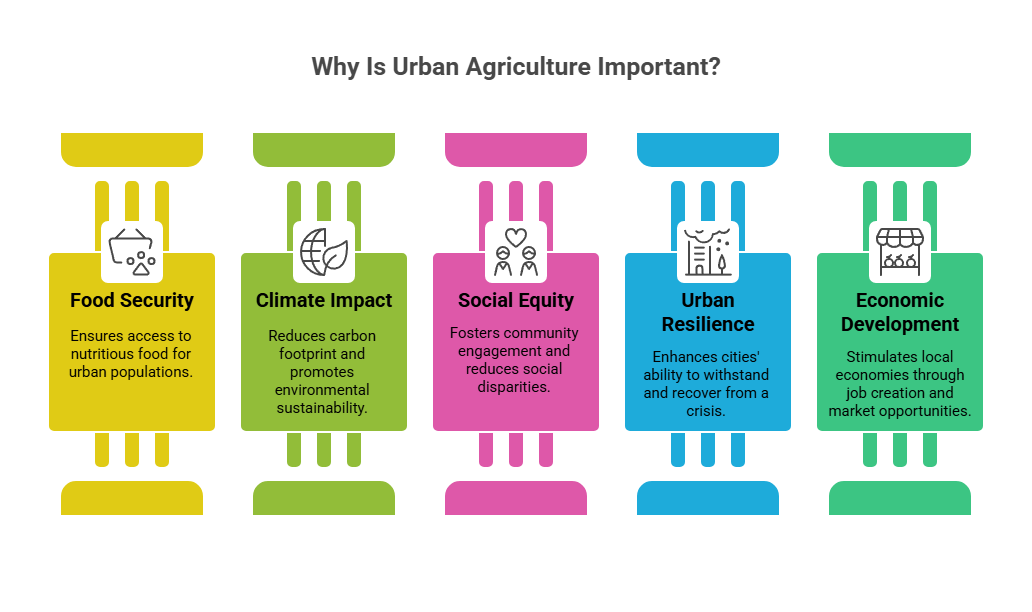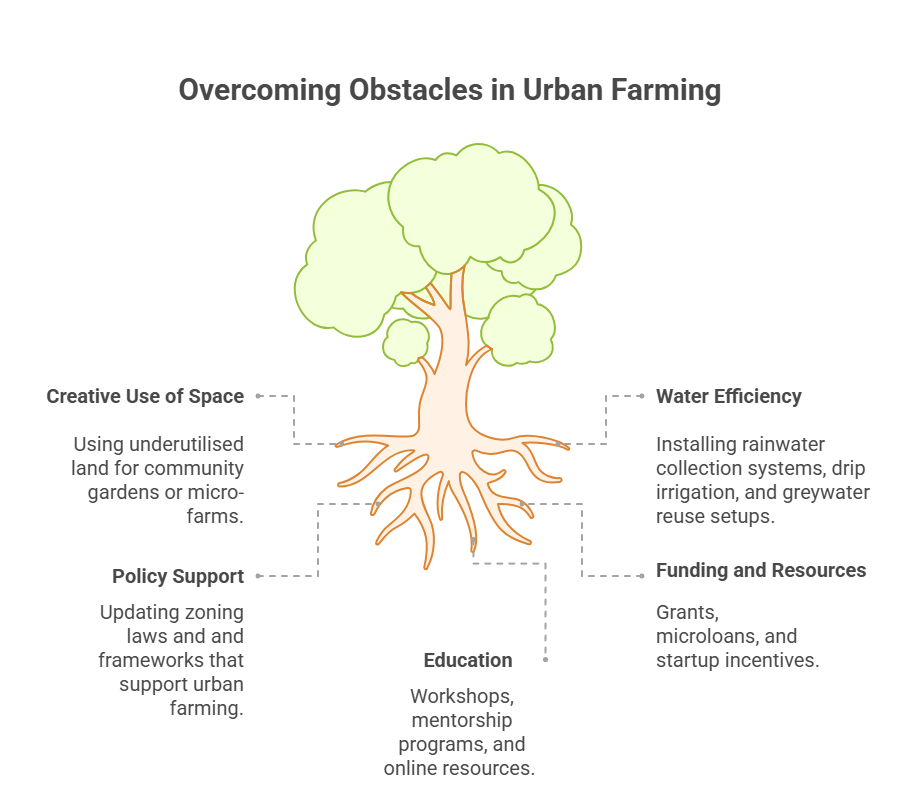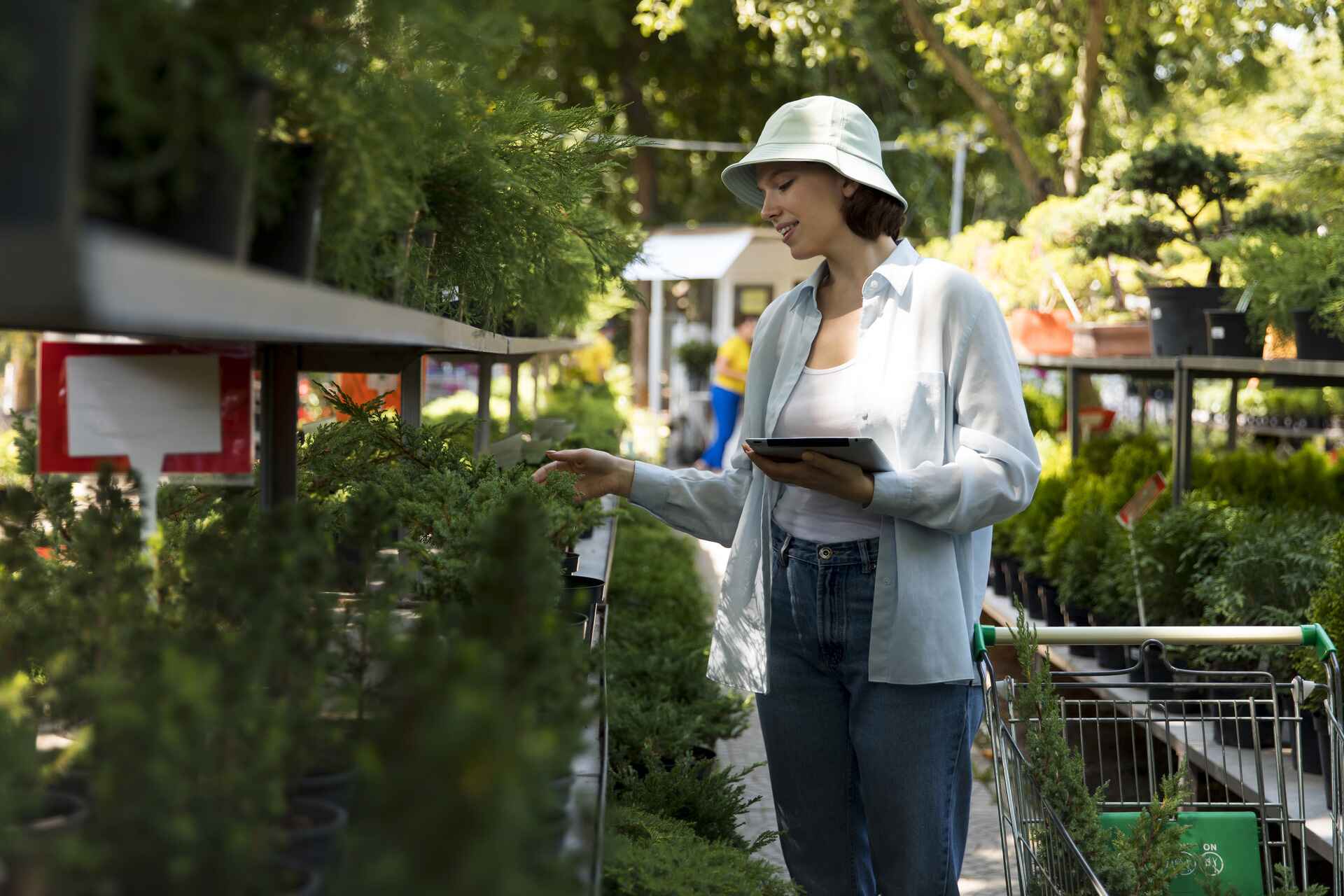Why Is Urban Agriculture Important: Exploring the Critical Role of Green Infrastructure
Learn why urban agriculture is important for food security, climate resilience, and sustainable city living in a changing world.
.webp)
Urban agriculture is the practice of growing food and greenery in cities. It plays an essential role in addressing food security, climate change, and community well-being. From rooftop gardens to vertical farms, these green systems reduce heat, improve air quality, create local jobs, and make fresh produce more accessible. While challenges like space, cost, and regulation exist, they can be overcome with smart planning and support. With proven results and growing demand, urban farming is becoming a key part of modern city life.
Urban agriculture is the practice of growing food and cultivating greenery within cities. It's definitely no longer a niche movement.
As urban populations grow, climate change is becoming an ever-prevalent issue. Not to mention that food security has become a major concern in different parts of the world.
That's why the importance of urban agriculture is a common discussion in terms of sustainability.
Urban agriculture can be seen in different forms, from rooftop gardens to vertical farms and community food hubs.
So, why is urban agriculture important today?
The answer spans economic, public health, climate, and community concerns.
As cities move toward an uncertain future, urban farming is emerging as a key part of the solution.
What Is Urban Agriculture?
Urban agriculture is also known as urban farming. It refers to the cultivation of food, plants, or greenery within cities.
Unlike traditional agriculture, urban agriculture often leverages unused or unconventional spaces. These could be:
- Rooftops
- Walls
- Balconies
- Alleys
- Brownfields
Urban agriculture embraces modern techniques. These include hydroponics, aquaponics, and vertical growing systems.
Common forms of urban farming include:
- Rooftop gardens
Often integrated with office buildings, schools, or apartment complexes. They're also known as green roofs. They help regulate building temperatures and reduce stormwater runoff.
- Green/living walls
Vegetated wall systems that grow herbs, leafy greens, or decorative plants. These systems can improve air quality and aesthetics. They also offer space-efficient growing solutions in dense areas.
- Community gardens
Neighbourhood plots for shared food production and education. They encourage social connections and shared responsibility. Community gardens often support local food banks or meal programs.
- Vertical farms
Tech-enabled indoor agriculture using stacked layers and controlled environments. They offer high-yield production in compact spaces. They also reduce the need for pesticides or long-distance transport.
- Edible landscapes
Public or private green spaces that include food-bearing plants. These multifunctional areas promote biodiversity. They offer both visual beauty and food-growing potential in everyday settings.

Why Is Urban Agriculture Important?
Urban agriculture is vital for several reasons, which include:
- Food security and community health
- Climate and environmental impact
- Social and economic equity
- Urban resilience
- Local economic development

Food Security and Community Health
Food deserts are an ongoing challenge in cities. These refer to areas with limited access to affordable, nutritious food.
These areas often don't have nearby grocery stores or markets that sell fresh fruits and vegetables.
Urban farming can help solve this problem.
By growing food right in the city, like in backyards, rooftops, or community gardens, people can get fresh produce close to home.
This makes healthy food easier to find and puts less pressure on long delivery systems.
Because the food doesn't have to travel far, it stays fresher, and there's less pollution from transportation.
This is better for both people and the environment.
Urban farms are especially helpful in low-income or remote areas where healthy food is harder to obtain.
They can improve diets and reduce health problems linked to poor nutrition.
Another big benefit is that communities can grow food that belongs to their culture and traditions.
This helps people stay connected to their roots while eating healthy.
Climate and Environmental Impact
Urban farming plays an important role in making cities more sustainable. It helps tackle several important climate and environmental problems.
First, green spaces like rooftop gardens or vertical farms can cool down cities.
They help reduce the urban heat island effect, which happens when streets, buildings, and concrete surfaces trap heat.
Adding plants to these areas lowers temperatures and makes neighbourhoods more comfortable.
Urban farms also help manage stormwater. Plants and soil absorb rainwater, which means less runoff and fewer floods.
At the same time, these green spaces support urban wildlife, including birds, bees, and other pollinators. This improves local biodiversity.
Another major benefit is cleaner air. Plants naturally filter the air, taking in carbon dioxide and releasing oxygen.
As they grow, they also capture carbon through photosynthesis, which helps fight climate change.
Social and Economic Equity
Urban farming isn't just about growing food.
It also helps build stronger, fairer communities. By creating jobs and learning opportunities, it supports both social and economic growth in cities.
One of the biggest benefits is job creation.
Urban agriculture can provide work in areas like:
- Gardening
- Landscaping
- Farm maintenance
- Social work
- Education
- Small business development
These roles are especially valuable in communities where employment options may be limited.
Urban farming projects also offer training programs that help people gain new skills.
Through hands-on learning, people can build confidence and work toward future job opportunities.
Schools and community groups can also use urban gardens as educational spaces.
They become places to teach kids about healthy eating, the environment, and how food is grown.
These experiences can inspire future careers in sustainability or agriculture.
Community gardens are especially important. They offer safe, welcoming places where people of all ages and backgrounds can come together.
Urban Resilience and Disaster Preparedness
When cities face crises, like floods, heatwaves, or supply chain breakdowns, urban farming becomes more than just a green trend.
It plays a practical role in helping communities stay safe, fed, and connected.
Urban agriculture is a key part of green infrastructure. It can strengthen cities in several important ways:
- Reduces flood risk
Gardens and green spaces absorb rainwater. This helps prevent stormwater from overwhelming drains and flooding streets.
- Provides local food access
Community gardens and small urban farms can quickly supply fresh produce when larger food systems are disrupted.
- Builds local capacity
People involved in urban farming are more connected and better informed. They're also more prepared to support each other during emergencies.
By turning underused spaces into productive green zones, cities don't only improve daily life. They also build resilience for the future.
These spaces are flexible. They can be scaled up during times of need or serve as gathering points for relief and communication.
Examples already exist. Cities like Hobart and Melbourne have added edible gardens to their climate adaptation plans.
This shows how green spaces can be both beautiful and functional in times of crisis.
Local Economic Development
Urban agriculture also helps grow local economies.
It creates new jobs, services, and business opportunities. It helps keep money circulating within the community and supports small-scale entrepreneurship.
When people start growing food in cities, it creates demand for local goods and services. This boosts small business activity and encourages innovation.
Here are some of the ways urban farming supports local economic growth:
- Boosts local supply chains
It increases demand for gardening tools, soil, compost, planters, and seeds — all of which can be sourced from nearby suppliers.
- Creates microbusiness opportunities
Services like home produce delivery, compost pickup, seedling sales, and plant nurseries can thrive in neighbourhoods with active urban farms.
- Encourages entrepreneurship
People can start their own farm stands, run local farmers' markets, offer workshops, or sell prepared food made with local ingredients.
Together, these activities help build a self-reliant and diverse urban economy.
This is especially valuable in underinvested areas. In these areas, traditional job opportunities may be limited.
This is exactly where community-led solutions can lead to long-term change.
Common Urban Agriculture Challenges
While urban farming has many benefits, it also comes with real challenges.
To grow successfully in cities, communities, and policymakers need to understand and address these barriers.
Some of the most common obstacles include:
- Limited space
Cities are crowded, and finding available land, especially land that's safe, accessible, and affordable, can be difficult.
- Access to water
Urban farms need reliable and affordable water sources. But in many areas, water is either scarce or expensive.
- Regulatory hurdles
Local laws and zoning rules may not support food production in residential or commercial areas. This makes it challenging for urban farms to operate legally.
- Funding and resources:
Starting and maintaining a farm requires tools, materials, and time. Without grants, community support, or investment, many projects struggle to survive.
- Knowledge gaps
Not everyone has access to the training needed to farm successfully. Lack of agricultural skills or experience can limit growth and impact.

Strategies for Overcoming Urban Agriculture Challenges
To make urban farming thrive, cities and communities must actively work to remove barriers and support long-term success.
Fortunately, there are practical strategies that can help overcome common obstacles.
Here are some key solutions:
- Creative use of space
Cities can start using underutilised land for community gardens or micro-farms. Temporary or modular farming setups can also adapt to small or unconventional spaces.
- Water efficiency and reuse
Installing rainwater collection systems, drip irrigation, and greywater reuse setups can reduce costs. It can also help urban farms operate sustainably, even during droughts or water restrictions.
- Policy support and zoning reform
Local governments can update zoning laws to allow food production in residential and commercial zones. Clear policies and support frameworks help legitimise urban agriculture and reduce legal roadblocks.
- Access to funding and resources
Grants, microloans, and startup incentives can provide the financial boost needed to launch or scale urban agriculture projects. Partnerships with local businesses, nonprofits, or schools can also share resources.
- Education and capacity-building
Workshops, mentorship programs, and online resources can help. It can be useful for building skills in sustainable farming, composting, and business development. Schools and youth programs are especially important for creating long-term knowledge.

Understanding the Importance of Urban Farming
Urban agriculture is more than just growing food in the city.
It's about building healthier communities, stronger local economies, and greener, more resilient places to live.
Urban farming has a wide range of benefits that touch nearly every part of city life, from improving food access and creating jobs to reducing heat and supporting the environment.
At Evergreen Infrastructure, we're passionate about helping cities grow smarter and greener.
Whether you're a local council, school, developer, or community group, we can help design and deliver sustainable green infrastructure, from edible gardens to green walls and rooftop farms.
Contact Evergreen Infrastructure to explore how we can support your vision and make urban farming part of your future.
{{cta}}
We create green oases in urban settings
We'd love to discuss how we can partner to bring innovative, sustainable solutions to your urban environment.
.webp)
.webp)
.webp)


